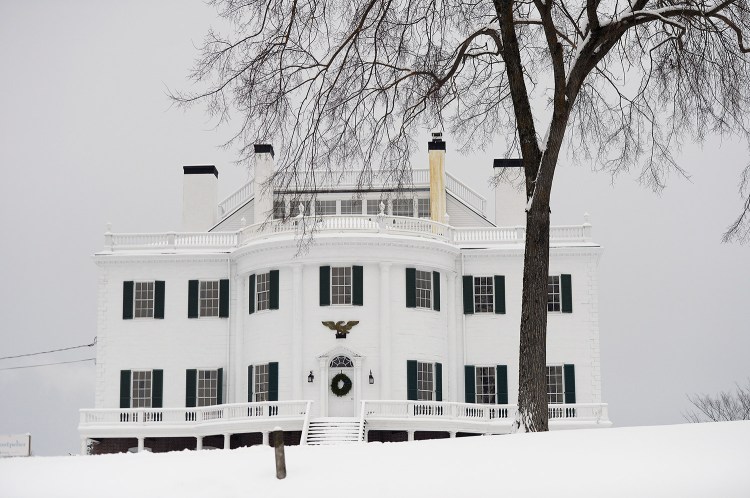THOMASTON — A replica of the historic former home of Maine Revolutionary War hero Henry Knox could be shuttered if the nonprofit that runs a museum there cannot raise $150,000 by the middle of January.
In a Dec. 15 letter to supporters, the Knox Museum says it’s facing a “dire” situation because the state, which holds rights to the property, has said it will collect the museum’s artifacts and either sell or abandon the building known as Montpelier.
The museum “serves to honor the life, times and military service of patriot, soldier, founding father and statesman Henry Knox, and the heritage of the museum’s 13-acre property and its signature building, Montpelier,” the museum’s website says.
The nonprofit Friends of Montpelier operates the museum and grounds. According to the most recent Form 990 tax return filed with the IRS, the organization was $132,000 in the red in 2015. It listed $237,000 in contributions and $406,000 in expenses, including $140,000 for administration and $212,000 for program services. The federal tax form also shows the nonprofit has about $5.7 million in total assets, mostly in real estate and artifacts.

Inside the Knox Museum is this semi-flying staircase. The nonprofit Friends of Montpelier operates the museum and grounds, but money from a major donor is nearly exhausted.
In 2015, the museum took in $39,000 from admissions and made another $51,000 from fundraising, while other contributors gave about $177,000 to the nonprofit. The federal tax forms do not identify the individual donors.
Peter Ogden, chairman of the museum’s board of trustees who signed the letter to supporters, did not respond to requests for comment Tuesday.
Knox was a general in George Washington’s Continental Army and later served as the first secretary of war for the newly formed United States. He is best known for his effort to bring cannons from Fort Ticonderoga in upstate New York to Boston during the winter of 1775-76. Knox died in Maine in 1806 after accidentally swallowing a chicken bone, which lodged in his throat and caused an infection.
The building in Thomaston is a 1929 reproduction of the original Knox home, which was built in 1794, fell into disrepair and was demolished by the Thomaston Railroad in 1871, the museum’s website says.

A painting of Gen. Henry Knox is displayed in the Knox Museum in Thomaston.
“The museum has largely been funded by a finite gift which has now been exhausted,” Ogden wrote in his letter. “Knox Museum has been informed by the state of Maine – who holds an historic easement on Montpelier and its collections – that should the museum close, in all eventuality the Knox Collections will be removed and the building known as Montpelier sold and/or abandoned.”
Tom Desjardins, director of Maine’s Bureau of Parks and Lands, which manages state historic sites, said the state does not consider the building historic because it is a replica and is not located on the site of the original Knox home. Desjardins said the state gave the property to the nonprofit in 1999 after failing to make the museum’s operations financially viable itself.
The friends group had done a remarkable job, Desjardins said, but he didn’t foresee the state continuing operations if the museum were to close. However, he said the state would work with the museum’s board of directors once it makes a final determination of what it wants to do.
“If somebody locally were to step forward and say ‘I’ll take it on,’ then we might talk with them about a lease,” Desjardins said. “But I can’t make a decision on what to do with it until they tell us what they want to do. But it’s hard for me to see the state turning it back into a state historic site and operating the way we do, say, Fort Knox.”
Few of the museum’s artifacts have a direct link to Knox, but if the museum were to close, the artifacts could be used at other state historic sites to help teach people about Maine history, Desjardins said. He also said if the state were to derive any revenues from the property, those funds would go toward historic site preservation or education.

Paintings of Knox family members are displayed in the Knox Museum. From left to right are Lucy Flucker Knox Thatcher, the oldest child of Henry and Lucy Knox; Marcus Camillus Knox; and James Keadie Swan, first husband of Caroline Knox.
“For our purposes, it’s not historic and it just wasn’t working financially so we gave it away,” Desjardins said, “with the stipulation that if they couldn’t make it work it would come back to the state and we would revisit it. And they have apparently arrived at that point or come close, because their major donor has stopped donating – the one that kept them solvent all those years.”
Desjardins said he didn’t believe the state could do a better job than the Friends of Montpelier has done.
“And they have done an amazing job, the programs they have there and the website,” he said. “They have done probably far better than we could have in terms of promoting and managing and holding events, and it just doesn’t work. There just isn’t enough of a draw of people to generate the revenues.”
Scott Thistle can be contacted at 713-6720 or at:
sthistle@pressherald.com
Twitter: thisdog
Send questions/comments to the editors.



